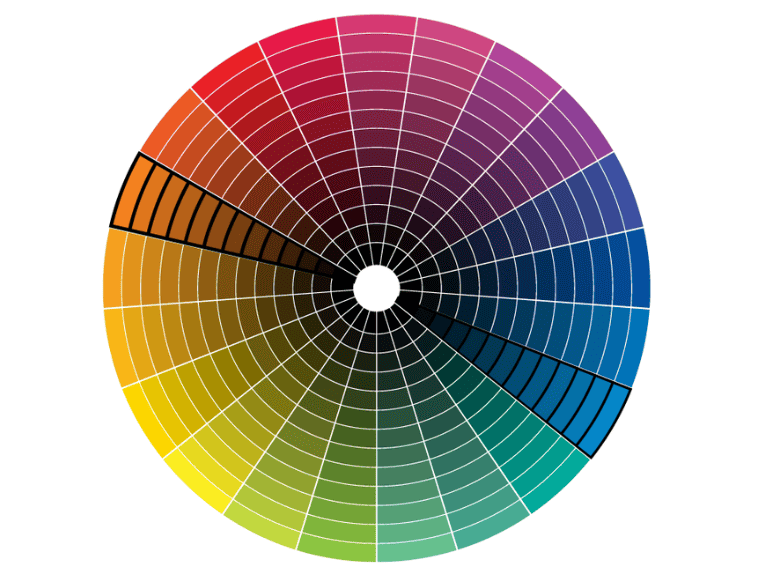Looking for the opposite of brown on the color wheel? Then you’ve come to the right place. In this article, you’ll learn all about the opposite brown color on the color wheel.
Brown has been among the most used colors since ancient times, thanks to a natural pigment called ‘umber.’ With a strong connection to nature, this color is associated with feelings of warmth, comfort, and earthiness.
Brown is not displayed on the traditional color wheel because it is not a pure hue but an umbrella term for dark shades of orange, yellow-orange, and red-orange.
Brown, however, can be seen as a shade of orange on the modern color wheel, which displays tints and shades for each hue.
In this article, you will discover:
- Why does the opposite color of brown vary depending on the model used?
- What color is the opposite of brown on different color wheels?
- How to use the opposite of brown depending on your medium?
- What are the opposite colors for different brown hues?
Let’s find out what the complementary color to brown is.
What is the Opposite of Brown in RGB?
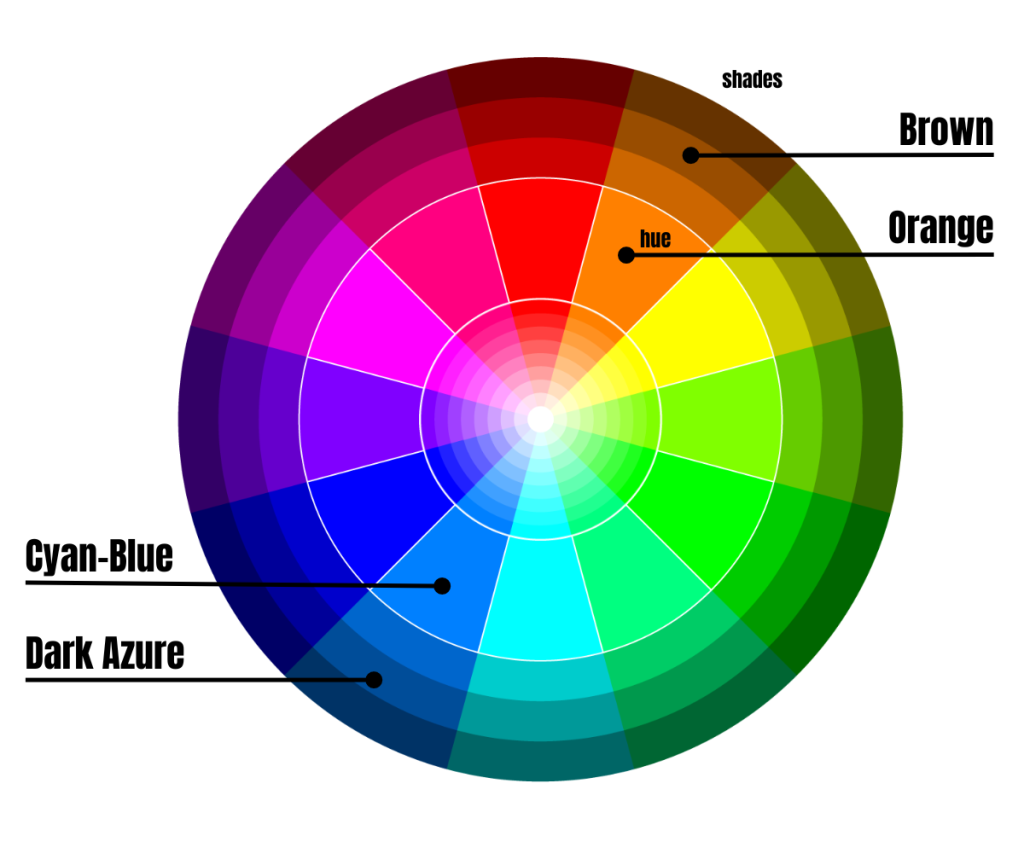
RGB is an additive color model that works with light. Its acronym stands for red, green, and blue primary colors.
So RGB combines the additive colors red, green, and blue. Additive color starts with black (dark or no light). When all three primaries are combined, you get white light.
When two primary colors are mixed in an equal proportion, the secondary colors cyan, magenta, and yellow are produced.
Tertiary colors are created by combining equal amounts of a primary and a secondary color. These colors are orange, chartreuse, spring green, azure, violet, and pink.
If you look at the RGB color wheel, brown is best portrayed by orange – in a dark version. This one sits opposite azure, a mix of blue and cyan.
Brown is a dark shade of orange, associated with comfort, reliability, and earthiness. The opposite of brown on the color wheel is Lapis blue – a medium-dark grayish blue.
Because it leans towards cyan on the color wheel, it can be perceived as a dark cyan blue.
Lapis blue has a hue of 210 degrees, a saturation of 100%, and a lightness of 29%.
In the LAB color system, this color has a grayish tint.
The grayish tint of this blue is caused by a slightly green undertone. So, its greenish tint contributes to its grayish appearance. The same goes for brown, being a mix of yellow with a little red at low brightness, which gives it the brownish hue.
Lapis blue is a little darker than Denim blue, which has a brightness of 36%.
Brown
Hex #964B00
RGB 150, 75, 0
CMYK 0, 50, 100, 41
Lapis Blue
Hex #004B96
RGB 0, 75, 150
CMYK 100, 50, 0, 41
What is the Opposite of Brown in CMY?
CMY is a subtractive color model that goes hand in hand with the RGB color wheel. The primary colors of one are the secondary colors of the other.
This subtractive model used in the printing industry works with cyan, magenta, and yellow as primary colors. The secondary ones are red, green, and blue.
In the CMY subtractive model, mixing a primary color with a secondary color produces the tertiary colors. These include orange, red-magenta, violet, blue-cyan, green-cyan, and yellow-green.
Brown in CMY is actually orange with the addition of black (also called “K” or “Key” in CMYK). Its opposite is blue-cyan – a mixture of the primary color cyan with the secondary color blue.
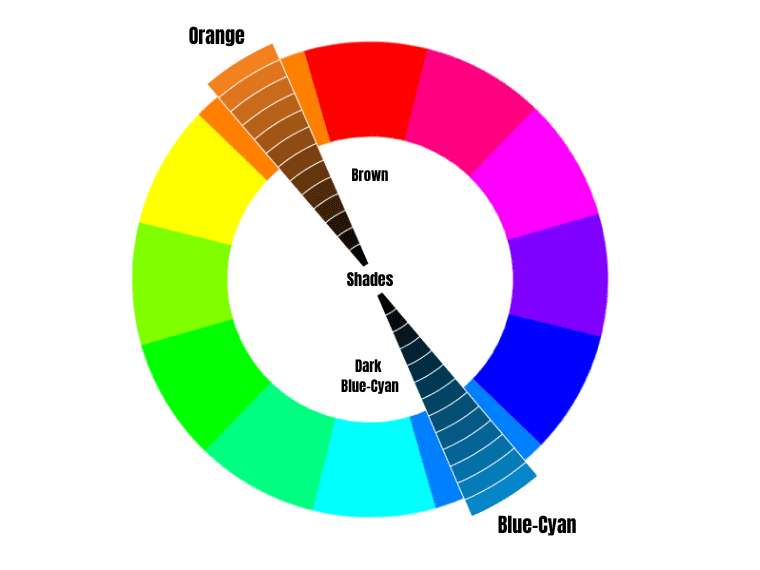
This model is called “subtractive” because it uses a process of subtracting colors from white light by absorbing them with pigments, dyes, or inks.
Mixing in this model starts with white (a piece of paper) and gets darker as color is added.
When we say that subtractive color mixing starts with white, we mean that if you start with a white light source, like sunlight, it contains all colors of the spectrum.
When you shine this light onto a white surface, like a blank piece of paper, you see white because all the colors are being reflected back to your eyes.
By adding pigment, dye, or ink, you subtract certain colors from the light that’s being reflected. For example, a cyan pigment absorbs red light and reflects blue and green light.
When combining blue and green light combine, you get cyan – one of its primaries.
Adding another pigment, like magenta, absorbs green and reflects blue and red.
But because the cyan pigment is already absorbing the red light, the only wavelength (or color) reflected by both pigments is blue. So when you mix cyan and magenta, you get blue.
In theory, if you mix cyan, magenta, and yellow pigments, they should absorb all colors of light and appear black.
However, because no pigments are pure, you usually end up with a dark brown or muddy color instead.
What is the Opposite of Brown in RYB?
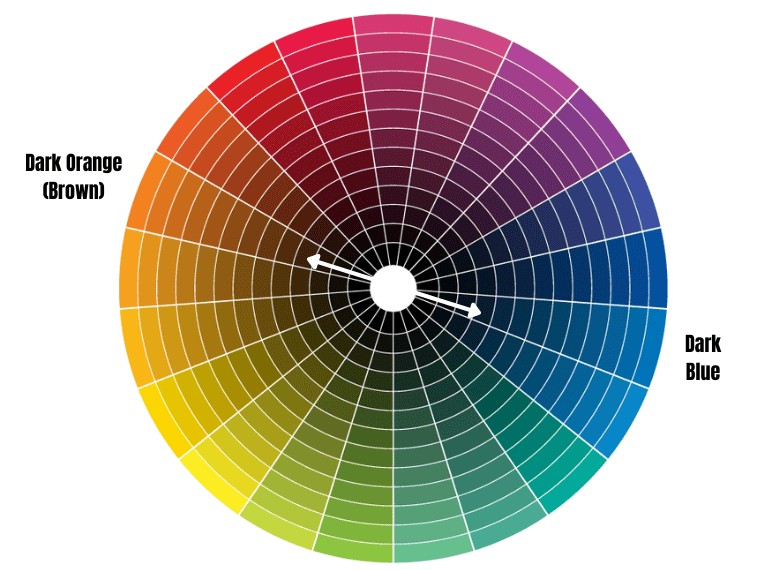
RYB is a subtractive color model used in traditional art.
If you were taught in school that the primaries are red, yellow, and blue, then you have learned about this color space. This model is used for mixing pigments.
The secondary colors produced by mixing two primary colors are orange, purple, and green.
Mixing a secondary with a primary color produces intermediate (also called tertiary) colors. These are amber (red-yellow), vermillion (red-orange), magenta (red-purple), violet (blue-purple), teal (blue-green), and chartreuse (yellow-green).
On the RYB color wheel, the opposite of brown is Ultramarine – a dark shade o blue with a violet bias.
Ultramarine is a deep blue that leans towards purple on the color wheel. This color complements brown because it is a dark orange that leans more towards amber (yellow-orange) than vermillion (red-orange).
Brown
Hex #964B00
RGB 150, 75, 0
CMYK 0, 50, 100, 41
Ultramarine Blue
Hex #000096
RGB 0, 0, 150
CMYK 100, 100, 0, 41
What are the Opposite Colors of Brown and Its Different Shades?
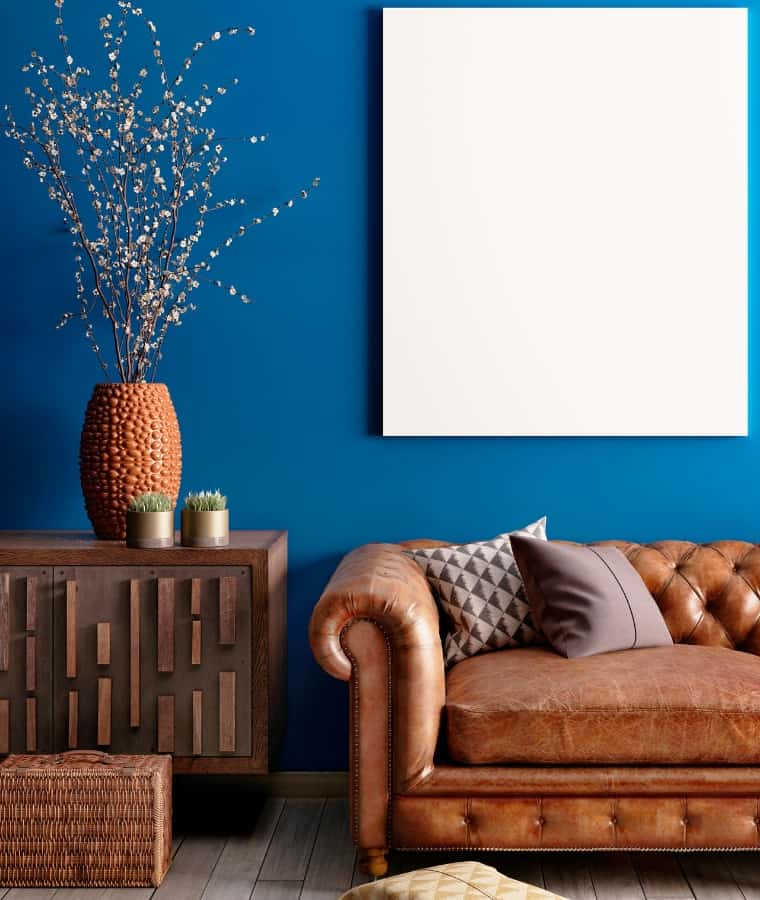
Brown comes in different shades and is often used as a generic term for dark shades of orange (browns), red-orange (reddish browns), or yellow-orange (tan).
Depending on the medium and shade used, the opposite of brown differs. When it comes to the RGB model, there are plenty of browns to choose from.
What Color is the Opposite of Light Brown?
Light brown symbolizes warmth, honesty, and friendliness. The opposite of light brown is Azul blue – a grayish blue that belongs to the Sky blue family.
Light brown
Hex #B5651D
RGB 181, 101, 29
CMYK 0, 44, 84, 29
Azul
Hex #1D6EB5
RGB 29, 110, 181
CMYK 84, 39, 0, 29
What is the Opposite of Buff?
The opposite of buff – a very light brown – is light Royal blue – a pale version of royal blue.
Buff
Hex #DAA06D
RGB 218, 160, 109
CMYK 0, 27, 50, 15
Light Royal Blue
Hex #6D7BDA
RGB 109, 123, 218
CMYK 50, 44, 0, 15
What is the Opposite of Russet?
Russet is a dark brown obtained by mixing orange and purple. Thus, it has a reddish-orange tinge. The opposite of russet is a grayish variation of Lapis Lazuli with hex code #1B5480.
Russet
Hex #80461B
RGB 128, 70, 27
CMYK 0, 45, 79, 50
Lapis Lazuli
Hex #1B5480
RGB 27, 84, 128
CMYK 79, 34, 0, 50
What is the Opposite of Chocolate Brown?
Here’s a darker shade than russet, called chocolate brown.
Chocolate is a dark shade of brown, which appeared as a color in 1734, illustrating the color of milk chocolate. Its opposite on the color wheel is Yale blue – a dark azure (cyan-blue).
Chocolate
Hex #7B3F00
RGB 123, 63, 0
CMYK 0, 49, 100, 52
Yale Blue
Hex #003B7B
RGB 0, 59, 123
CMYK 100, 52, 0, 52
What Color is the Opposite of Latte?
Latte is a pale, muted brown, slightly darker than tan. Its opposite on the color wheel is pastel blue, similar to Vista blue.
Latte
Hex #C5A582
RGB 197, 165, 130
CMYK 0, 16, 34, 23
Dark Pastel Blue
Hex #82A2C5
RGB 130, 162, 197
CMYK 34, 18, 0, 23
What is the Opposite of Burnt Umber?
Burnt umber is a reddish-brown inspired by the color of the natural pigment Umber – a brown pigment formed from iron oxide and manganese oxide. This color was popular in the Baroque period.
The color that sits opposite burnt umber on the color wheel is teal – a blue-green color.
Burnt umber
Hex #8A3324
RGB 138, 51, 36
CMYK 0, 63, 74, 46
Teal Blue
Hex #247B8A
RGB 36, 123, 138
CMYK 74, 11, 0, 46
What is the Opposite of Maroon?
Maroon is a dark shade of red that looks like a brownish-red. It is associated with strength and passion.
The opposite of maroon on the color wheel is teal – a deep blue-green. Teal combines the serenity of blue with the freshness of green.
Maroon
Hex #800000
RGB 128, 0, 0
CMYK 0, 100, 100, 50
Teal
Hex #008080
RGB 0, 128, 128
CMYK 100, 0, 0, 50
What is the Opposite of Sienna?
Pigment in its natural form is called raw sienna – a yellowish brown. When heated, it takes on a reddish hue. Thanks to this pigment, sienna was among the most used shades of brown by Renaissance artists.
The opposite of sienna is cerulean blue. This is a deep blue inspired by a blue pigment from the 19th century. Moreover, this antique pigment was created from cobalt and copper compounds.
Sienna
Hex #A0522D
RGB 160, 82, 45
CMYK 0, 49, 72, 37
Cerulean
Hex #2D7CA0
RGB 45, 124, 160
CMYK 72, 22, 0, 37
What Color is the Opposite of Coffee?
Coffee is a dark brown that looks like roasted coffee beans. The opposite color of coffee brown is Payine’s gray – a deep grayish blue.
Coffee
Hex #6F4E37
RGB 111, 78, 55
CMYK 0, 30, 50, 56
Marengo
Hex #37586F
RGB 55, 88, 111
CMYK 50, 21, 0, 56
What is the Opposite of Caramel Brown?
Caramel is a light golden brown, slightly darker than copper. The color that sits opposite caramel on the color wheel is UCLA Blue – a medium-dark azure color.
Caramel
Hex #B67233
RGB 182, 114, 51
CMYK 4, 51, 84, 21
Bice Blue
Hex #3377B6
RGB 51, 119, 182
CMYK 72, 35, 0, 29
What is the Opposite of Copper?
Copper is a brownish-orange named after the metal of the same name that has been used by humans since 8000 BC. Thus, the use of copper to make tools helped people emerge from the Stone Age. [1]
However, you can find many variations from brownish-orange to reddish-brown – closer to the color of this metal.
The opposite color of copper is French blue – a medium blue with a grayish appearance.
Copper
Hex #B87333
RGB 184, 115, 51
CMYK 0, 38, 72, 28
French Blue
Hex #3378B8
RGB 51, 120, 184
CMYK 72, 35, 0, 28
What is the Opposite of Taupe?
Taupe is a grayish brown, symbolizing simplicity, comfort, and maturity.
The opposite of taupe is air superiority blue – a pale cyan-blue. It is similar to azure but lighter.
Taupe
Hex #B38B6D
RGB 179, 139, 109
CMYK 0, 22, 39, 30
Air Superiority Blue
Hex #6D95B3
RGB 109, 149, 179
CMYK 39, 17, 0, 30
What is the Opposite of Cafe au Lait?
This is a darker variation of taupe, reminiscent of the café-au-lait color, as its name suggests.
Cafe au lait is a muted light-medium brown inspired by a popular coffee and milk froth drink. The opposite of cafe au lait is a medium variation of azure called Air force blue.
Cafe au lait
Hex #A67B5B
RGB 166, 123, 91
CMYK 0, 26, 45, 35
Air Force Blue
Hex #5B86A6
RGB 91, 134, 166
CMYK 45, 19, 0, 35
What is the Opposite of Cinnamon Brown?
Cinnamon is a brownish-orange that looks like the spice of the same name obtained from the bark of the Cinnamomum verum tree.
Since orange sits on the opposite side of azure on the color wheel, the opposite of cinnamon is Bleu de France – a cyan-blue color.
Cinnamon
Hex #D2691E
RGB 210, 105, 30
CMYK 0, 50, 86, 18
Bleu de France
Hex #1E87D2
RGB 30, 135, 210
CMYK 86, 36, 0, 18
What is the Opposite of Tan?
The color tan is a light brown whose name was inspired by tanning – a process of transforming animal hide into leather.
Its opposite color is boy blue – a pale grayish blue.
Tan
Hex #D2B48C
RGB 210, 180, 140
CMYK 0, 14, 33, 18
Boy Blue
Hex #8CAAD2
RGB 140, 170, 210
CMYK 33, 19, 0, 18
What is the Opposite of Fawn?
Fawn is a pale yellowish brown named after fawn dog breeds. However, shades can vary from light tan to dark yellowish brown.
The opposite of fawn is Ruddy blue, a grayish cyan-blue.
Fawn
Hex #E5AA70
RGB 229, 170, 112
CMYK 0, 26, 51, 10
Ruddy Blue
Hex #70ABE5
RGB 112, 171, 229
CMYK 51, 25, 0, 10
What is the Opposite of Dark Brown?
Although it borrows a little of the sadness of black, dark brown represents strength and humility.
The opposite of dark brown is midnight blue – a dark shade of blue often perceived as a blackish-blue.
Dark Brown
Hex #654321
RGB 101, 67, 33
CMYK 0, 34, 67, 60
Midnight Blue
Hex #212165
RGB 33, 33, 101
CMYK 67, 67, 0, 60
Last Words on the Opposite Color of Brown
Brown is a dark shade of orange, and orange sits opposite blue on the color wheel. Thus, the complementary color of brown is dark blue.
However, depending on the shade of brown, the brown’s complementary color can range from blue-green for reddish browns (or dark red-orange) to blue-violet for yellowish browns (or yellow-orange).
Discover more colors that go with brown.
Did you like this article about the opposite of brown on the color wheel? Share it with your friends who love brown.

